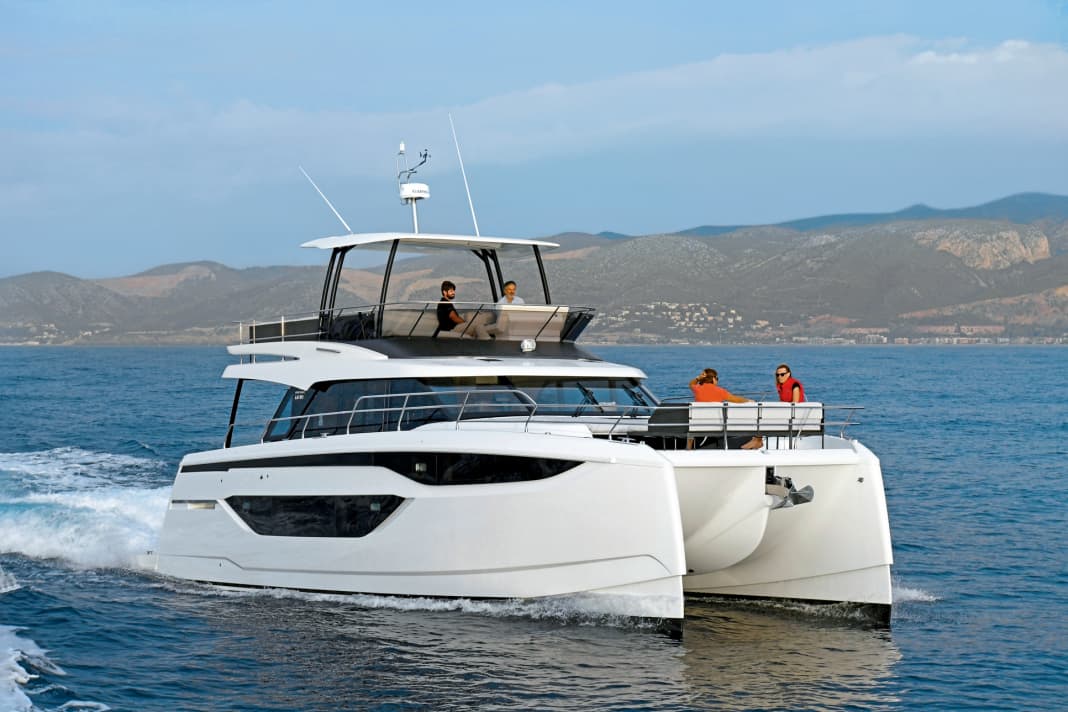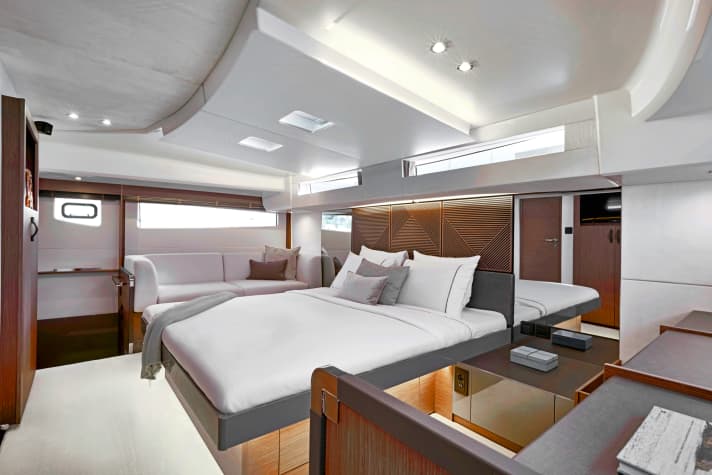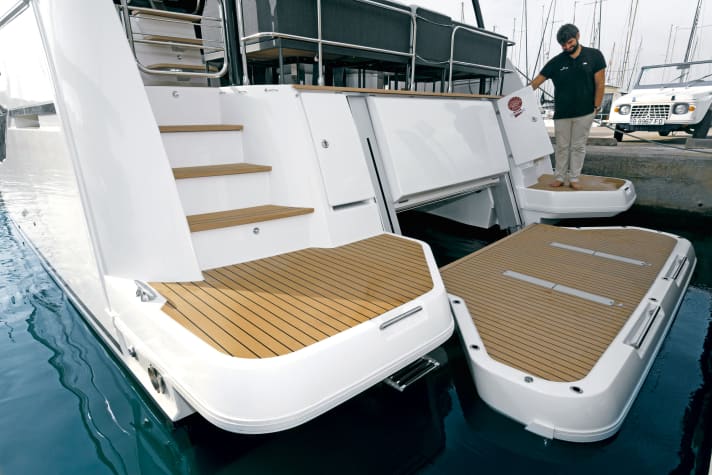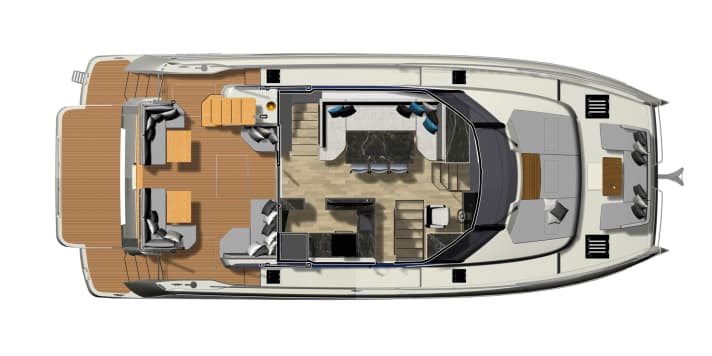Prestige M48: On board the catamaran - Economical family cruises






When planning its first catamaran, Prestige presumably carried out a detailed analysis before the launch, as the competition had already established itself in this segment. With the knowledge of what works more or less well for other manufacturers, the shipyard in Les Herbiers was able to optimise its project. The Garroni design studio - which designs the entire Prestige range - is responsible for the project. The shipyard has enlisted the services of Philippe Briand, one of the world's leading architects and a confidant of Groupe Beneteau.
With the M48, the special challenge was the master cabin, which makes the big difference and is obviously the key to the project. In a 13-14 metre long cruising catamaran, the hulls and the tunnel are technical constraints that limit the design possibilities and the cabins. Prestige avoids these constraints by extending the gondola. This type of intermediate deck accommodates the owner's suite, which extends across the entire width of the boat, including the hulls. Thanks to the deck hatches, front and side windows, there is plenty of light in the cabin. The toilet room is located on one side and the shower on the other; the two rooms are well organised and offer a high level of comfort.
Freedom of movement on board not impaired
Of course, this arrangement also has an impact on the overall design. The continuous forward cabin forced the architect to raise the hulls in order to create a sufficiently large tunnel. The result is a freeboard of 2.50 metres at the hulls and a maximum clearance height of 5.90 metres. At 6.00 metres wide, the catamaran is narrower than its competitors. To achieve this, Prestige has decided to reduce the width of the gangways without compromising the freedom of movement on board.
As soon as you enter the saloon, you will find a galley on the starboard side, which is bordered by two corner modules. A hinged window provides a direct connection to the cockpit. Valentina Militerno (Camillo - Garroni's partner) provided decorative details such as marble-like ceramic coatings on the worktop and the large, fixed table in the saloon. A sliding side door leads to the starboard side deck. The low height of the door frame requires some contortions when passing through, but the passage should prove practical nonetheless. On the same side is the helm station with driver's seat, which is installed on a storage locker. The distance between the seat and the helm was incorrectly dimensioned and the seating position is therefore quite uncomfortable. However, the shipyard has promised to remedy this.
Several cabins on board the Prestige M48
The M48 is available with three or four cabins. In the charter version (four cabins), the owner's suite is divided into two equally sized cabins, each with a bathroom. The hulls house the other two cabins with single beds, which can be pushed together to form a 1.60 metre wide bed. The space and headroom (1.97 m) are remarkable.

Light furniture and trendy applies to the cockpit, where there is a huge storage space that is primarily accessible from the stern. Like her competitor, the Leopard 46 The M48 also has a lift in the centre of the bathing platform (can also be used for the dinghy). The majority of the outdoor equipment consists of furniture from the Italian specialist Roda. Prestige has dispensed with the fixed plastic benches and instead opted for sofas and armchairs with a lightweight frame that are attached to the floor with invisible poles. This fashionable decision offers a certain flexibility and saves weight, especially on the high flybridge.

Economical family cruises with the Prestige M48
The same principle can be found in the bow, where an optional long sofa leans against the bow railing. The arrangement is unusual, but works well with the double sunbed on the deckhouse. The Prestige M48 Cat has been optimised for family cruises and focuses on economy. With 2-x-320 hp Volvo Penta D4 engines with V-drive, the catamaran approaches the 20-knot mark at full throttle - but doesn't quite reach it. Performance and fuel consumption are almost equally good at speeds between 15 and 18 knots. But as always with a catamaran, you have to stay below 10 knots to drastically reduce consumption and switch to "trawler mode". At 8.5 knots, consumption is 16 l/h, i.e. less than two litres per nautical mile. This promises a crossing from the mainland to Corsica with less than 200 litres of diesel.
The hulls are well balanced and glide smoothly. The wide bow spoiler effectively reduces the spray that is often observed on catamarans above 12 knots. The crew will be pleasantly surprised by the noise level of the M48. The engines are located in a closed, well-enclosed compartment and are absolutely unobtrusive. In the harbour, the optional Volvo joystick system is useful, for example, for dropping the Powercat, which is moored to the jetty. With an engine in each hull, manoeuvring is child's play. Many skippers say that it is difficult to switch back from a catamaran to a monohull once you have acquired a taste for it. This has been confirmed.
Technical data
- Shipyard: Prestige Yachts/F
- Type: Prestige M48
- CE category: B/12
- Length over everything: 14,79 m
- Width: 6,00 m
- Weight: 18 t
- Berths: 6
- Motorisation: 2 x Volvo Penta D4-320, 235 kW (320 hp)
- Maximum motorisation:2 x diesel engine 235 kW (320 hp)
- Base price (with 2 x 320 hp): €1,236,410
- Contact: www.prestige-yachts.com


Michel Luizet

